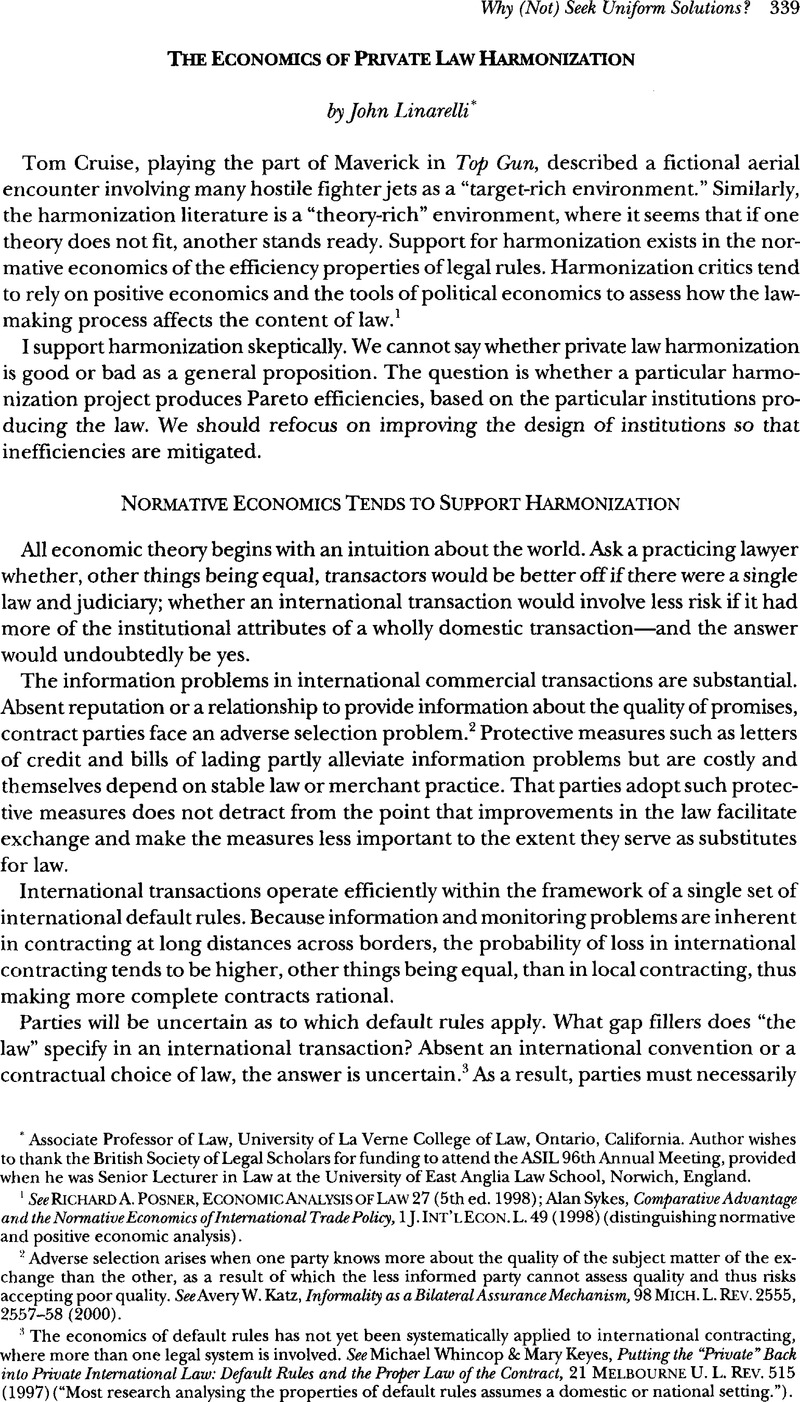Article contents
The Economics of Private Law Harmonization
Published online by Cambridge University Press: 28 February 2017
Abstract

- Type
- Why (Not) Seek Uniform Solutions?
- Information
- Copyright
- Copyright © American Society of International Law 2002
References
1 See Posner, Richard A., Economic Analysis of Law 27 (5th ed. 1998)Google Scholar; Sykes, Alan, Comparative Advantage and the Normative Economics of International Trade Policy, 1 J. Int’l Econ. L. 49 (1998)CrossRefGoogle Scholar (distinguishing normative and positive economic analysis).
2 Adverse selection arises when one party knows more about the quality of the subject matter of the exchange than the other, as a result of which the less informed party cannot assess quality and thus risks accepting poor quality. See Katz, Avery W., Informality as a Bilateral Assurance Mechanism, 98 Mich. L. Rev. 2555, 2557-58 (2000)CrossRefGoogle Scholar.
3 The economics of default rules has not yet been systematically applied to international contracting, where more than one legal system is involved. See Whincop, Michael & Keyes, Mary, Putting the “Private” Back into Private International Law: Default Rules and the Proper Law of the Contract, 21 Melbourne U. L. Rev. 515 (1997)Google Scholar (“Most research analysing the properties of default rules assumes a domestic or national setting.”).
4 ICC Comments on the “Communication from the European Commission to the Council and the European Parliament on European Contract Law,” COM(2001) 398 final, Oct. 15, 2001.
5 Id.
6 The dichotomy between harmonization and diversity is not as stark as conceptualized. Framing the question whether law is harmonized or not runs the risk of missing the essential elements of how law is produced and how it has evolved in various states. Even common law Juris dictions like England have experienced “codification” or “rationalization” by Blackstone, Coke, and others. There is a long history of cross-fertilization between western legal traditions. U.S. courts have used restatements liberally; in prior centuries they cited English law. The question could more properly be reframed as: What kind of harmonization is preferred? Legal diversity is a continuum. It does not manifest itself in the law in action as an either/or proposition. Taken to its logical conclusion, legal diversity is a tautology, as it would mean total decentralization, a purely theoretical situation.
7 See Cooter, Robert, The Cost of Coase, 11 J. Legal Stud. 1 (1982)CrossRefGoogle Scholar.
8 Basedow, Jürgen, The Case for a European Insurance Contract Code, 2001 J. Bus. L. 569 (2001)Google Scholar.
9 The Rome Convention provides that unless the parties otherwise specify, consumer contracts are governed by the law of the consumer’s habitual residence, and in no circumstances can choice of law deprive the consumer of the protection of the laws of her country of residence where that law is more favorable. Rome Convention on the Law Applicable to Contractual Obligations June 19, 1980, art. 5, 19 ILM 1492 (1980).
10 See, e.g., London Investment Banking Association Comments on “Communication from the Commission to the Council and the European Parliament on European Contract Law,” COM(2001) 398 final.
11 Schwartz, Alan & Scott, Robert E., The Political Economy of Private Legislatures, 143 U. Pa. L. Rev. 595, 605 (1994)CrossRefGoogle Scholar; Stephan, Paul B., The Futility of Unification and Harmonization in International Commercial Law, 39 Va. J. Int’l L. 743 (1999)Google Scholar. Schwartz and Scott examine U.S. domestic institutions only, using the formal modeling techniques of positive political theory. Stephan extends the Schwartz and Scott analysis informally to international institutions.
12 Basedow, supra note 8.
- 2
- Cited by




